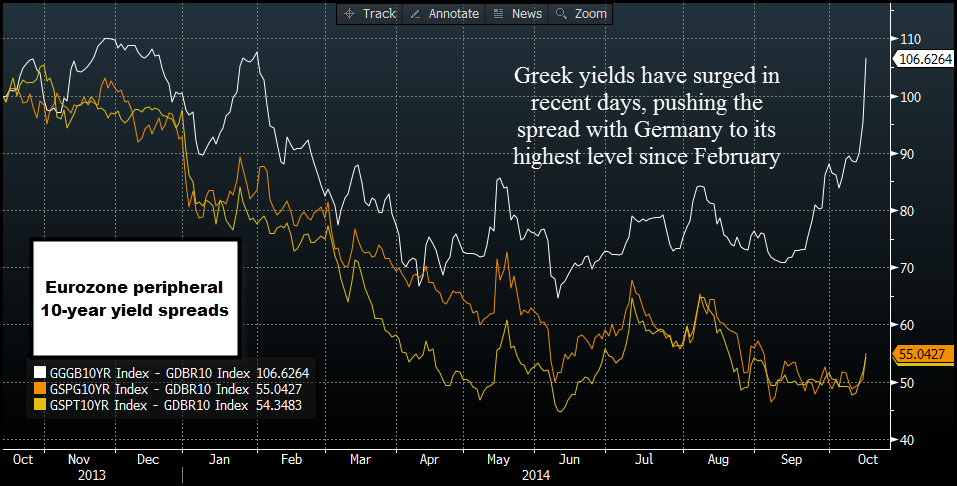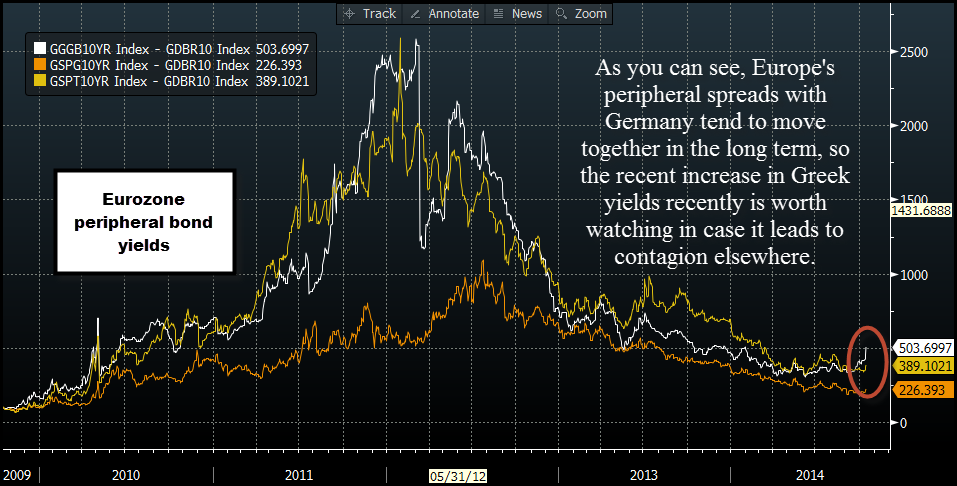![]()
A major shift has happened in the last couple of days, Greece, who everyone thought was on the mend, saw its bond yield cross an important line. If you cast your mind back 3 years you may remember that in the heat of the sovereign debt crisis, when Europe’s struggling periphery saw their bond yields cross above 7%, it was considered the point of no return. Well, late on Tuesday, Greek 10-year yields did just that, they crossed this important line, and have continued to push higher on Wednesday.
I did not expect to be watching Europe’s peripheral yield spreads with Germany. However, this old chestnut is back and the chart below shows Greek (white), Spain (orange) and Portugal (yellow) 10-year bond yields with Germany. As you can see in figure 1, Greek yield spreads have risen sharply, Portuguese yields have turned higher, and the Spanish spread has also started to widen. At this stage, the contagion effects are minimal, as Spanish and Portuguese yield spreads with Germany are still at relatively low levels. However, as you can see in figure 2, Greek, Spanish and Portuguese yield spreads have tended to move in the same direction for most of the last 5 years, although Greek yields have tended to overshoot more. This does not bode well for the other “at risk†countries in the Eurozone.
So why are peripheral risks rising right now?
Growth fears: Europe’s growth forecast was revised down by the IMF for this year and next year, disinflation has taken a firm hold and even Germany is showing signs of stress. This is not good when you have a giant pile of debt. In fairness, Europe could do with a little inflation to eat away at its debt pile, which is why it is imperative that the ECB takes more action to get rid of the threat of deflation. Read my colleague Matt’s piece from Tuesday HERE. http://www.forex.com/uk/post?SDN=ea33f244-4a84-48c4-9d23-a2b5d508886a&Pa=20db1fa6-e674-420c-9a87-2ee29261d638
Germany: As we mention above, even Germany is struggling. The ZEW survey for October suggests that there is a good chance that the US will fall into technical recession this year. If Germany’s economy starts to suffer, who is going to pay for all the bailouts? This essentially leaves Europe without a true lender of last resort, which could make some of Europe’s most troubled nations less credit-worthy.
Political risks: Some of Europe’s member states have fragile governments right now. The French government nearly collapsed earlier this year, Italy’s Five Star Movement is gaining popularity once again and trying to get Italy to leave the currency bloc; in Greece the radical leftist anti-EUR party SYRIZA hold a strong lead in the opinion polls. The Greek political issues could continue to grow if the current government do not win a majority at next year’s Presidential election then SYRIZA could call a snap election putting them in a good position to run the country.
Rising bond yields are merely a reflection of the troubles that have resurfaced in the currency bloc. We tend to think that the economy is the biggest threat, and if growth does not pick up sometime soon then we could see rising bond yields spread beyond Greece into Portugal, Spain and even Italy.
Right now, there is no sovereign crisis, but the fact that Greek yields have crossed the 7% threshold is a warning sign that all is not well. Investors are ditching the highest risk peripheral debt and ploughing their money into German yields, 10-year German yields have fallen to another record low on Wednesday, which suggests that stress levels could be starting to rise.
What now for the EUR?
EURUSD is shrugging off the Greek news, for now, however if yields continue to rise and we see 8 or 9% in 10-year Greek bond yields, or if we see contagion start to spread and other peripheral yield spreads start to rise, then it could trigger some selling pressure in the single currency. We continue to think that the risks to the EURUSD are to the downside, and the market could fade any rallies towards 1.2680 and then 1.2710. In the short term, the first level of support is 1.2625 then 1.2600; however the main target is still 1.2500, the low from 3rd October.
CFD’s, Options and Forex are leveraged products which can result in losses that exceed your initial deposit. These products may not be suitable for all investors and you should seek independent advice if necessary.
Recommended Content
Editors’ Picks
EUR/USD alternates gains with losses near 1.0720 post-US PCE

The bullish tone in the Greenback motivates EUR/USD to maintain its daily range in the low 1.070s in the wake of firmer-than-estimated US inflation data measured by the PCE.
GBP/USD clings to gains just above 1.2500 on US PCE

GBP/USD keeps its uptrend unchanged and navigates the area beyond 1.2500 the figure amidst slight gains in the US Dollar following the release of US inflation tracked by the PCE.
Gold keeps its daily gains near $2,350 following US inflation

Gold prices maintain their constructive bias around $2,350 after US inflation data gauged by the PCE surpassed consensus in March and US yields trade with slight losses following recent peaks.
Bitcoin Weekly Forecast: BTC’s next breakout could propel it to $80,000 Premium

Bitcoin’s recent price consolidation could be nearing its end as technical indicators and on-chain metrics suggest a potential upward breakout. However, this move would not be straightforward and could punish impatient investors.
Week ahead – Hawkish risk as Fed and NFP on tap, Eurozone data eyed too

Fed meets on Wednesday as US inflation stays elevated. Will Friday’s jobs report bring relief or more angst for the markets? Eurozone flash GDP and CPI numbers in focus for the Euro.

